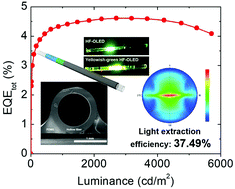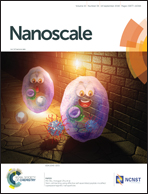High-performance, color-tunable fiber shaped organic light-emitting diodes†
Abstract
In recent years, extensive research has been undertaken to develop fiber-shaped optoelectronic devices, because they are aesthetically pleasing, light in weight, and exhibit superior light emitting properties when compared with conventional planar analogues. In this work, we have successfully developed hollow-fiber shaped organic light emitting diodes (HF-OLED) with an exceptionally high luminance and facile color tunability. The HF-OLED device was fabricated by hierarchically depositing amorphous indium-doped tin oxide electrode on a hollow-fiber, followed by the sequential deposition of light-emitting organic layers and Al cathode. The external quantum efficiency of the HF-OLED is more than ∼2.0 times higher than that of a planar-OLED. The experimental results are in good agreement with the output of optical simulations, revealing that the use of a hollow-fiber has contributed to a ∼2.3 times improvement in light extraction efficiency. Furthermore, the color emission of a single HF-OLED device could be easily tuned from a green to yellowish-green wavelength after the injection of a super-yellow solution. The novel color tunable nature of the HF-OLED further broadens its application in the field of modern lighting and display technology.



 Please wait while we load your content...
Please wait while we load your content...